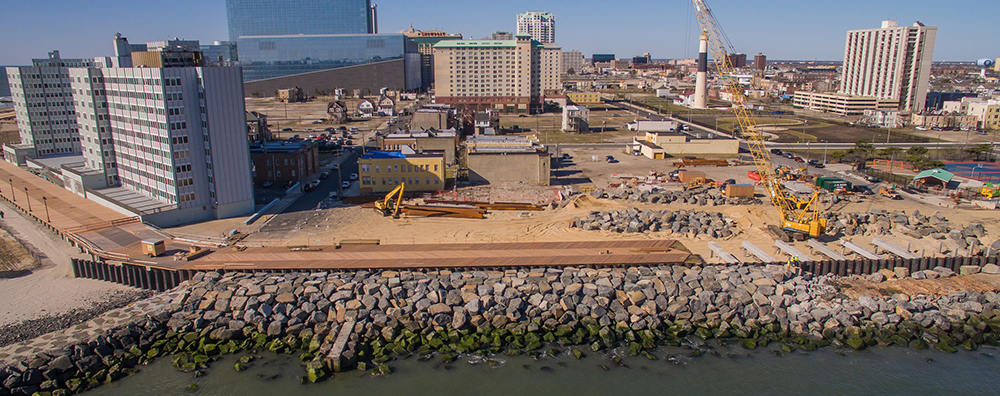 A U.S. Army Corps of Engineers project in New Jersey will create a seawall to reduce coastal storm damage. ©U.S. Army Corps of Engineers, 2017.
A U.S. Army Corps of Engineers project in New Jersey will create a seawall to reduce coastal storm damage. ©U.S. Army Corps of Engineers, 2017.
The safety net of resilience is woven from many different strands of community involvement—local planners, lawmakers, private businesses, residents, finance brokers, insurance companies, and numerous other influencers, large and small.
With so many varying interests and viewpoints at play, it can be easy to miss opportunities to build resilience into community plans and projects. Recently, however, the American Bar Association has stepped in to provide a unifying voice on the issue of resilience.
The Association’s House of Delegates—which represents more than 400,000 members—unanimously passed a resolution urging decision makers to take action to make communities more resilient from hazards, while still recognizing property rights, protecting the environment, and looking out for citizen interests.
“A robust community resilience program represents the interests of the entire community and is contingent upon the ongoing collaboration of civic leaders, key public and private sector stakeholders, and community members,” a [report] (http://bit.ly/2rjhtpd) accompanying the resolution states. “It spans activities ranging from preparing for hazard events, risk mitigation and post-event recovery, and should be proactive, continuous, and integrated into other community planning.”
The report also encourages lawyers, law firms, and others to advocate for programs, policies, and practices that foster resilient communities and reduce disaster risk.
“The ABA and other bar associations are uniquely positioned to help save lives and money by developing best practices and standards promoting resilience to disaster,” the report states. “One of the core ways the ABA and other bars can foster this resilience is helping identify the characteristics of laws and policies that tend either to augment or impair community resilience.” Adopting the resolution isn’t just giving lip service to a great concept, though, according to the report’s authors.
“It’s an incredibly powerful that the ABA leadership adopted this,” said Edward Thomas, President of the Natural Hazard Mitigation Association and a member of the ABA Committee on Disaster Preparedness and Response, which drafted the report. “It’s an incredibly powerful statement.”
Along with that statement will come a bevy of educational activities to give ABA members and associated groups a better understanding of the many ways resilience can be incorporated into community planning. From webinars to workshops to a planned book project, the resolution is already creating a space to have a conversation about disaster risk reduction in the context of community planning.
“I think this is a clarion call for changing the way we do community development,” Thomas said.
One of the ways the ABA Disaster Preparedness Committee is assuring that is by reaching out to other professional organizations to get buy in and spread the word. Those efforts are in their early stages, but organizations such as American Society of Civil Engineers, the National Institute of Building Sciences, and the National Fire Protection Agency have reviewed the resolution and provided positive feedback, said George Huff, special advisor to the committee.
Huff, a long-time continuity professional, pointed out that while planning processes and political support can be mercurial, consensus in the professional realm was more likely to effect long-lasting change. Drafting the document to complement other efforts, such as the National Institute of Standards and Technology’s Community Resilience Initiative, also assure the resolution will have stay power.
“In my experience, this is how these things get done,” he said. “It’s good to have a long-term approach to this kind of subject matter and that’s what we were going for.”
Jolie Breeden is the lead editor and science communicator for Natural Hazards Center publications. She writes and edits for Research Counts; the Quick Response, Mitigation Matters, Public Health, and Weather Ready Research Award report series; as well as for special projects and publications. Breeden graduated summa cum laude from the University of Colorado Boulder with a bachelor’s degree in journalism.